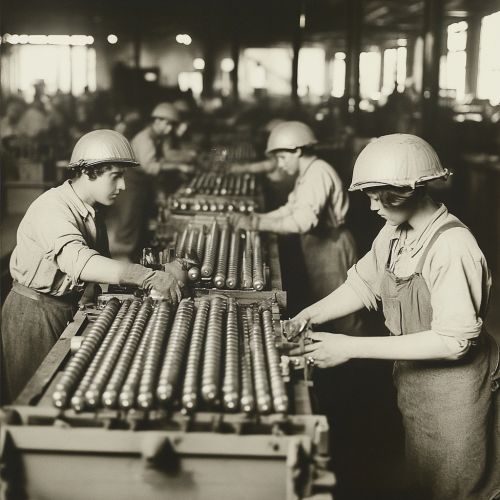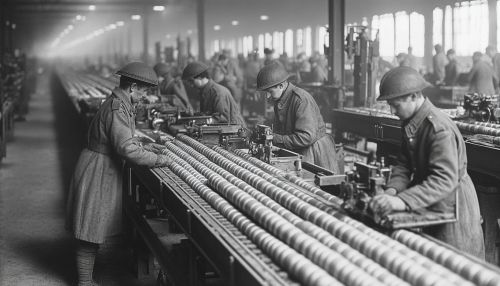Home front during World War I
Introduction
The home front during World War I was a critical aspect of the war effort, influencing the outcome of the conflict as much as the battles fought on the front lines. The term "home front" refers to the civilian populace and activities of a nation whose armed forces are engaged in war abroad. During World War I, the home front became a theater of war in its own right, with governments mobilizing entire societies to support the war effort. This article explores the various dimensions of the home front during World War I, including economic mobilization, social changes, propaganda, and the impact on daily life.
Economic Mobilization
The economic mobilization of the home front was a monumental task, requiring the reorganization of national economies to support the war effort. Governments took unprecedented control over industries, labor, and resources to ensure the production of war materials and supplies.
Industrial Production
Industries were rapidly converted to produce military goods, with factories shifting from consumer goods to munitions, vehicles, and other war-related products. This transition was facilitated by government contracts and incentives, which prioritized military needs over civilian consumption. The United Kingdom established the Ministry of Munitions in 1915 to oversee this transformation, ensuring that factories met the demands of the war.


Labor Force Changes
The war effort required a massive labor force, leading to significant changes in employment patterns. With many men conscripted into the military, women entered the workforce in unprecedented numbers, taking on roles traditionally held by men. This shift not only filled labor shortages but also began to alter societal perceptions of gender roles. In the United States, the War Industries Board coordinated the allocation of labor and resources, ensuring that industries met the needs of the military.
Rationing and Resource Management
Rationing became a common practice on the home front to ensure that sufficient resources were available for the military. Governments implemented systems to control the distribution of food, fuel, and other essential goods. In Germany, the Hindenburg Program aimed to increase war production by centralizing control over resources and labor, though it faced challenges due to blockades and resource shortages.
Social Changes
The war brought about profound social changes, reshaping societies in ways that would have lasting impacts.
Women's Roles
As women entered the workforce in greater numbers, they took on roles in factories, transportation, and even agriculture. This shift challenged traditional gender norms and laid the groundwork for future movements for women's rights. In the United Kingdom, the Women's Land Army was formed to support agricultural production, highlighting the essential role women played in maintaining food supplies.
Class and Social Mobility
The war also affected class structures, as the demand for labor provided opportunities for social mobility. Working-class individuals found employment in higher-paying industrial jobs, while the war effort blurred class distinctions as people from different backgrounds worked together toward a common goal.
Public Health and Welfare
The war prompted advancements in public health and welfare systems. Governments recognized the need to maintain a healthy workforce and implemented measures to improve sanitation, nutrition, and medical care. In the United States, the American Red Cross played a crucial role in providing medical services and support to both soldiers and civilians.
Propaganda and Public Opinion
Propaganda was a powerful tool used by governments to shape public opinion and maintain support for the war effort. Through various media, including newspapers, posters, and films, governments sought to influence perceptions and attitudes.
Media and Censorship
Governments exercised control over the media to ensure that information aligned with national interests. Censorship was employed to suppress dissent and maintain morale, with newspapers and other publications required to adhere to government guidelines. In France, the Bureau de la Presse monitored and controlled the dissemination of information to the public.
Patriotic Campaigns
Patriotic campaigns were launched to encourage enlistment, promote war bonds, and foster a sense of national unity. Iconic images, such as the British "Your Country Needs You" poster featuring Lord Kitchener, became symbols of the war effort. These campaigns aimed to rally citizens around the cause and sustain morale during difficult times.
Impact on Daily Life
The war had a profound impact on daily life, affecting everything from family dynamics to leisure activities.
Family and Community
Families experienced significant upheaval as men went to war and women took on new responsibilities. Communities rallied together to support one another, with local organizations and charities providing assistance to those in need. The absence of men also led to changes in family structures, with women often becoming the primary breadwinners.
Leisure and Entertainment
Leisure activities were adapted to reflect wartime realities. Theaters and cinemas offered patriotic performances and films, while sports events were organized to raise funds for the war effort. In Germany, the Kriegsbrot (war bread) became a symbol of the sacrifices made by civilians, as traditional foods were replaced by substitutes due to shortages.
